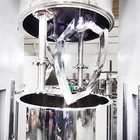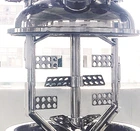Integrating development, manufacturing and sales, as a first-level mixer emulsifier factory.
Sources
Selecting the right mixing equipment can be a complex decision—especially when you're working with high-viscosity materials like adhesives, sealants, putties, or solder paste. Many mixers appear to offer similar capabilities at first glance, but subtle differences in function and design can have a significant impact on performance and product quality.
Among the available options, the Double Planetary Mixer (DPM) stands out for its versatility, performance, and adaptability, making it a smart long-term investment for many types of manufacturing environments.
However, before focusing on the DPM and its adaptability, we will first examine two other machines: the Solder Paste Mixer and the Sigma Kneaders & Multi-Shaft Mixers. This will give you all the information needed to make an informed choice based on their features and a clearer understanding of their differences.
When it comes to processing emulsions, creams, gels, or suspensions, many machines seem to do the same thing at first glance — they mix, blend, and homogenize. However, just because they look similar doesn’t mean they’re built for the same job.
In this article, we break down the real differences between a Homogenizer and a Vacuum Emulsifying Mixer, so you can make an informed decision for your production needs.
Small batch cosmetic production is a practical and flexible way to develop skincare, body care, and beauty products without committing to large-scale infrastructure. Whether you’re a formulator working from a lab or a brand running pilot production, using the right tools ensures consistency, safety, and quality from the first batch.
But it’s not just about convenience — in cosmetics, equipment directly affects product texture, stability, and safety. A mistake during blending or packaging can compromise not only the formula but also consumer health and brand integrity.
This guide outlines the essential lab equipment for small batch manufacturing, the risks of contamination, and the benefits of testing and scaling smart.
As highlighted in our article “Top 5 Mistakes to Avoid When Buying a Filling Machine: Technical Mistakes,” choosing the right filling equipment is complex and highly dependent on the nature of the product being handled. This is particularly true for thick, viscous products, where the technical demands differ greatly from those for thin, free-flowing liquids.
Due to their consistency, thick products present challenges in flow behavior, air handling, hygiene, and container compatibility—areas where standard filling equipment often fails. Investing in the wrong machine can lead to issues like product waste, high maintenance costs, and extended downtime. Ultimately, this affects both operational efficiency and profitability.
In this article, we will focus specifically on the technical solutions to these challenges. For a more comprehensive perspective, including financial and supplier-related considerations, refer to our full series: Top 5 Mistakes to Avoid When Buying a Filling Machine.
Deciding to upgrade to larger-scale production means you're expecting to produce more — and with that comes more complexity. Without a clear plan, the transition can be stressful. That’s why we’ve broken down the key steps to help you make this move as smoothly and successful as possible, both for your company and your team.
Emulsions play a crucial role in both the food and cosmetic industries. Whether it’s a rich béarnaise sauce, a dairy-based cream, a luxurious moisturizer, or a pharmaceutical ointment, the quality of an emulsion affects how a product looks, feels, tastes, and performs over time.
An emulsion is a stable mixture of two immiscible liquids—usually oil and water. Achieving a consistent, appealing, and durable emulsion is a technical challenge that standard mixers often struggle to meet.
Industrial mixing processes often involve complex materials that require careful handling to maintain their quality and performance. One key factor that can significantly impact the efficiency and outcome of mixing is temperature control—specifically, the use of heating and cooling systems integrated into industrial mixers.
Whether you are mixing adhesives, food products, chemicals, or pharmaceuticals, maintaining the right temperature during the mixing process is essential to ensure product consistency, prevent degradation, and speed up production. In this article, we’ll explore why heating and cooling systems matter, how they work, and what features to consider when selecting your next industrial mixer.
Many companies underestimate how much the nature of their product can influence the choice of mixing equipment. Choosing the wrong machine can result in wasted time, money, and raw materials. That’s why identifying the key characteristics of your product—such as viscosity—is essential. Viscosity refers to how thick or thin a material is, and it plays a critical role in determining the right mixing solution.
In our previous article, “Top 5 Mistakes to Avoid When Buying a Filling Machine: Technical Mistakes,” we explored how viscosity affects filling processes. In this article, we’ll focus on the best mixing machines for high-viscosity products.
Investing in a full production line is a major step in food and process manufacturing. It’s a decision that touches on cost, output potential, process optimization, and long-term business goals. For many, the move from individual machines to a fully integrated setup is both promising and daunting.
So, is it the right choice for your business?
When a company invests in a new machine — whether it's a filling machine, double planetary mixer, or even a lab-scale system — the first thought is usually the cost and return on investment. The question becomes: “Will this machine make us money?”
While that's a valid and important consideration, it's just as critical to look beyond ROI and focus on what comes with it: Compliance and Safety.
It’s easy to assume that safety and compliance features are already included in any machine, and that you don’t need to worry about it. But overlooking these factors can be dangerous — not only for your team, but also for your entire company.
There are many types of filling machines, each designed for specific products and production needs. At first glance, the variety can feel overwhelming. But once your needs are clearly defined, the decision becomes easier. Still, even with a good idea of what you want, it’s easy to overlook key factors that can impact your efficiency, costs, and future growth.
In this article, we’ll walk through the most common Operational and Capacity-Related Mistakes companies make when purchasing a filling machine. These points are explained in a simple, practical way to help you avoid costly errors down the line. If you need more specific guidance, feel free to reach out — we’re happy to help.
no data
Contact us now
CONTACT US
Tel: +86 -159 6180 7542
WhatsApp: +86-136 6517 2481
Wechat: +86-136 6517 2481
Email: sales@mautotech.com
Add:
No.300-2, Block 4, Technology Park, Changjiang Road 34#, New District, Wuxi City, Jiangsu Province, China.
Copyright © 2025 Wuxi MAXWELL Automation Technology Co., Ltd -www.maxwellmixing.com | Sitemap
Contact us
Leave your inquiry, we will provide you with quality products and services!
Contact us
email
wechat
whatsapp
Contact customer service
Contact us
email
wechat
whatsapp
cancel
Customer service














































































































